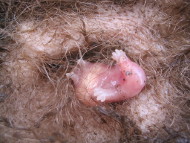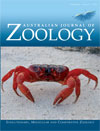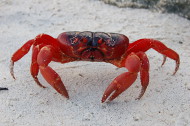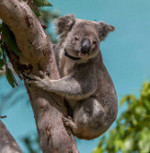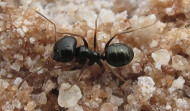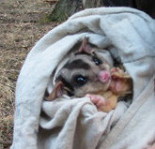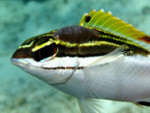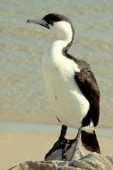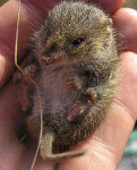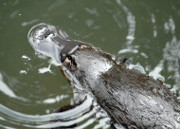Australian Journal of Zoology
Volume 60
Number 5 2012
Parental care is central to the differences in reproductive behaviour and energy expenditure between males and females. We investigated the extent of post-gestation maternal care in a wild population of Tasmanian short-beaked echidnas (Tachyglossus aculeatus setosus) and relate our findings to energy expenditure by the mother and female reproductive strategies.
Photo by Gemma Morrow.
Endo-β-1,4-glucanase and β-glucohydrolase from Gecarcoidea natalis synergistically hydrolyse carboxymethyl cellulose to glucose. This may be due to the complementary nature of the products of endo-β-1,4-glucanase activity and the preferred substrate of the β-glucohydrolase. This result supports the previous suggestion that G. natalis possesses a novel two-enzyme cellulase system.
Photo by Stuart Linton.
We compare the genetic diversity of naturally occurring and introduced island and mainland populations of koalas. The population on St Bees Island, Queensland, shows higher diversity than other island populations and mitochondrial haplotypes on the central Queensland islands are most similar to a haplotype found at Springsure in central Queensland.
Photo by Ken Bohn.
The ant Melophorus sp. (as yet unnamed) lives in the dry salt-pans of South Australia. Foragers are thermophilic scavengers, and rely on path integration for navigation. Due to the extreme openness of its habitat, this species provides an interesting system for the comparative study of navigation in desert ants.
Photo by Sebastian Schwarz.
Squirrel gliders were radio-tracked to examine nocturnal habitat use and characteristics of feeding sites. Gliders showed a significant preference for large healthy trees of particular species and they utilise these key feeding structures in different parts of the landscape at different times. These findings have direct management implications.
Photo by Mason Crane.
Almost 15% of bridled monocle breams (Scolopsis bilineatus) show signs of infection by the ectoparasitic cymothoid isopod Anilocra nemipteri at Lizard Island, northern Great Barrier Reef. Parasitised S. bilineatus were 25% smaller than unparasitised or previously parasitised fish, suggesting that A. nemipteri influences the size structure of its host population.
Photo by Dominique G. Roche.
We used the D-loop region of mitochondrial DNA to identify the fish presently occupying Lake Eacham and determine the likely source population. Analysis revealed that the species is Melanotaenia splendida and is most closely related to several populations in the immediate vicinity.
Photo by Culum Brown.
We describe the development of four novel microsatellite loci in black-faced cormorants, an Australian brood-reducing seabird, using 454-shotgun sequencing. We tested these loci in four other Australian cormorant species, showing utility beyond the focal species. These loci will be useful in determining genetic family structure in brood-reducing species.
Photo by Peter Day.
This study tested the hypothesis that allochthonous marine inputs subsidise an island population of the swamp antechinus (Antechinus minimus). Marine nutrients benefited insular antechinus both directly through the consumption of seabird carrion, and indirectly via increased ecosystem productivity, ultimately supporting a high-density population.
Photo by Michael Sale.
Platypus populations were monitored along streams near Melbourne and in western Victoria. Adult females typically moved about one-third as far as adult males between consecutive captures. Adult ranges extended up to 13.9 km (male) and 4.4 km (female). Two juvenile males dispersed >40 km.
Photo by Sharon Wormleaton.
